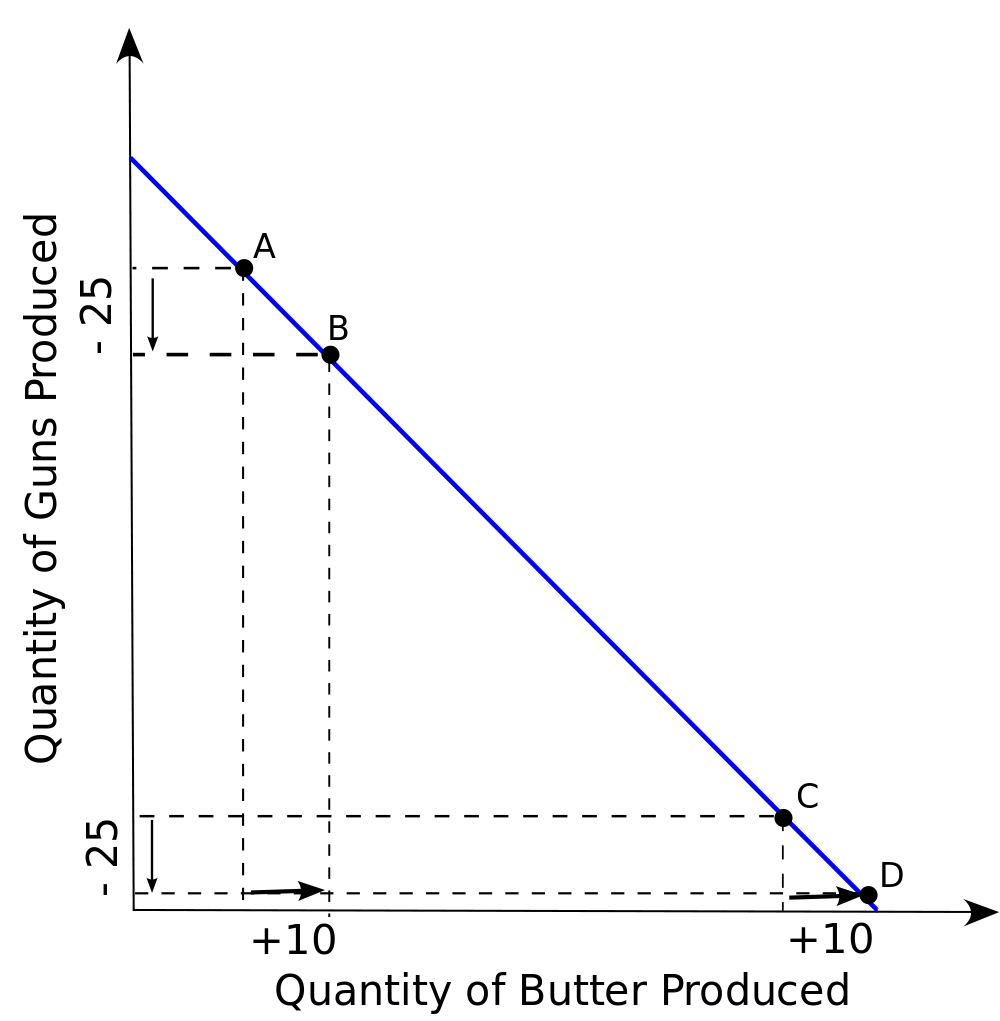Although intuition may suggest that a concave curve and a linear curve imply a convex curve, one is never presented. It is a "mystery"! Yet after looking through some journal articles, there seems to be a vast literature on the conditions specifying the shape of the frontier. Wikipedia even has a picture of what a convex production possibilities frontier would look like:
In this post I try to sketch out a simple model of a production possibilities frontier, and then try to explain some of the insights that can emerge from the more mathematical analysis.
I start out with a two industry economy, M and N, that uses only one input: labor. Both industries follow Cobb-Douglas production functions with a and b > 0.
As with most production possibilities frontiers, full employment is assumed, so:
Where P is the total population. With this substitution, both of the production equations can be solved for LM, which can be rewritten as L, resulting in:
Setting these equal to each other allows one to solve for M as a function of N:
Differentiating once with respect to N yields:
What is interesting to note is that the first derivative must be less than zero, regardless of the values of a or b.
As
And since, according to the original production functions:
We find that:
This analysis, along with the properties of the equations in the form of
Collecting terms and factoring yields:
The part in the square brackets is the punchline in our adventure. With the previous analysis about positives and negatives in mind, the only terms in the equation for the second derivative that could affect the sign of the second derivative are (a-1) and (b-1).
This creates a few cases for the second derivative of the production possibilities frontier. If both a>1 and b>1, then both production functions correspond to increasing returns to scale, with a frontier that has a positive second derivative, making it convex. This corresponds to the "bowed in" shape that can be described as "decreasing opportunity costs". Note again that this does not say the total amount of good M given up is decreasing, but rather that the amount of the good given up for each marginal unit of N is decreasing.
If both a<1 and b<1, then the production functions correspond to decreasing returns to scale, and the second derivative of the frontier is negative, making it concave, much like the traditional "increasing opportunity costs" case. And if both a=b=1, the production functions are constant returns to scale, the second derivative of the frontier is zero, making it linear, corresponding with the "constant opportunity costs" frontier.
What is elegant about this conclusion is that the three types of production frontiers correspond very nicely to the three modes of production: increasing returns with decreasing opportunity costs, decreasing returns with increasing opportunity costs, and constant returns with constant opportunity costs. Therefore, while the traditional example of guns and butter makes sense for the increasing opportunity costs case, the decreasing opportunity costs case would require an example with scale economies, such as those seen in technology fields or in infrastructure. An example would be the production of plane flights or train rides. In each of these industries, initial capital costs to build the airports or the railroads are very high. But after some are built, subsequent investments are cheaper due to a network effect. As a result, both industries are subject to increasing returns, and their combined production frontier can exhibit decreasing opportunity costs. Of course, this can only hold true as long as scale economies persist. If both industries revert back to diseconomies of scale at high production levels, the frontier in those regions will exhibit increasing opportunity cost. However, what this analysis has gone to show is that there is good reason for why frontiers can have zones of convexity, exhibiting the "mysterious" property of decreasing opportunity costs.



hey yichuan wang, do you know how the convexity/concavity of the ppf is derived if it has two input factors?
ReplyDeleteExperience life-changing fitness camps and resorts for adults and teens. No other weight loss boot camp, fat camp or farm gets you in shape for life. We do! ... “I FELT SO GOOD I ASKED FOR A PROMOTION, AND GOT IT!”. best fat camp for adults
ReplyDeleteVenus Factor? This is the number 1 reason women should NEVER diet like men. Female fat loss tips to lose weight naturally. fat loss factor
ReplyDeleteWow i can say that this is another great article as expected of this blog.Bookmarked this site.. keto diet for weight loss
ReplyDeleteConsider Cobb-Douglas technology f(k,l) with different parameters for both goods say 0.5 and 0.5 for good X and .25 and.75 for good Y. While both goods have constant returns to scale, the PPF is concave. How does this reconcile with your argument?
ReplyDeleteThank you again for all the knowledge you distribute,Good post. I was very interested in the article, it's quite inspiring I should admit. I like visiting you site since I always come across interesting articles like this one.Great Job, I greatly appreciate that.Do Keep sharing! Regards, forskolin free trial offer
ReplyDelete